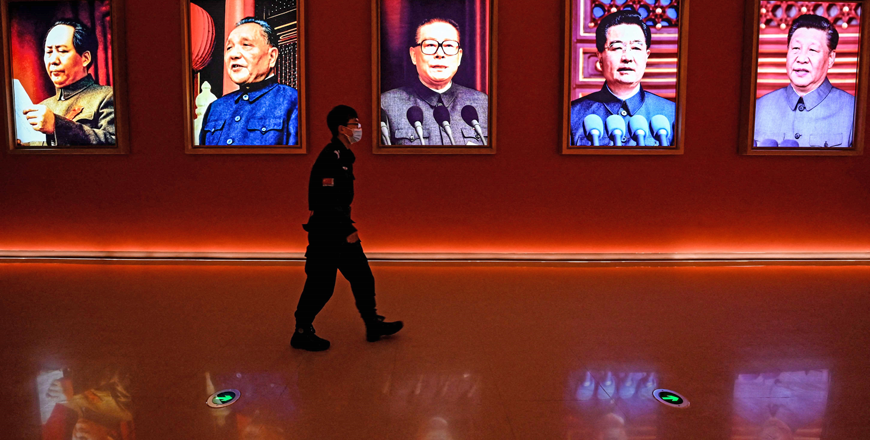You are here
Xi invokes Mao in visit to cradle of Communist revolution
By AFP - Oct 29,2022 - Last updated at Oct 29,2022

This file photo taken on October 15 shows a man walking past portraits of (from left to right) late Chinese chairman Mao Zedong and former Chinese leaders Deng Xiaoping, Jiang Zemin, Hu Jintao and current president Xi Jinping at Yan’an Revolutionary Memorial Hall in Yan’an city, China’s northwest Shaanxi province, on the eve of the 20th Communist Party Congress (AFP photo)
BEIJING — Dressed in matching navy windbreakers and flanking President Xi Jinping, China’s freshly appointed top leadership this week made their first group outing to the Communist Party’s “holy land”.
Xi’s choice to visit Yan’an — a site inextricably linked with Communist China’s founder Mao Zedong — was an important, deliberate indication of the themes of his next five years at the helm, analysts said.
Xi has centralised and personalised power more than any Chinese leader since Mao, culminating in his being anointed with a historic third term following last weekend’s Communist Party (CCP) Congress.
The new Politburo Standing Committee he shepherded around the popular “Red tourism” destination on Thursday consists solely of his loyal allies.
“The signal with the visit to Yan’an is one of celebrating a parallel [with Ma]) and brooking no opposition,” wrote Manoj Kewalramani from the Takshashila Institution in Bengaluru, India.
A 16-minute news segment about the visit on state broadcaster CCTV showed several portraits of Mao, and a report by the official Xinhua news agency mentioned the former leader’s name 14 times.
The itinerary included visits to Mao’s former residence, as well as a hall where a pivotal CCP meeting in 1945 confirmed him as chairman, apparently showcasing Xi’s deep interest in party history and its influence on his rhetoric and policies.
But it also harked back to an era when the CCP relied on mass “struggle” to win a bloody civil war, which observers believe has parallels with how Beijing views the current geopolitical climate.
“Among the signals Xi appears to be sending... is prepare for difficult times ahead, and prepare for struggle,” analyst Bill Bishop wrote in his Sinocism newsletter.
Xi took the 2012 standing committee to an exhibition about national rejuvenation in Beijing, and the 2017 one to the site of the first CCP Congress in Shanghai.
“The first travels after each Party Congress seems to be about ‘remember the original mission’,” tweeted the Australian National University’s Wen-Ti Sung.
According to state media, Xi on Thursday vowed that his new standing committee would “inherit and carry forward the fine revolutionary traditions formed by the party during the Yan’an period”.
Cradle of the revolution
Yan’an is revered in Communist Party lore as the cradle of the movement.
Nestled in the remote, arid mountains of northwest China, it was where party members hunkered down after the Long March, a gruelling year-long expedition by foot across the country to escape encirclement by Nationalist troops during the Chinese Civil War.
Tens of thousands died en route, and by the time the survivors arrived in Yan’an, they were a severely weakened force.
Mao and his allies, including Xi’s father, lived alongside local peasants in caves as they planned military campaigns.
The CCP’s eventual victory over the Nationalists saw the Yan’an period codified as a shining example of the Party’s ability to overcome adversity.
Yan’an is also firmly linked to Mao and his consolidation of power.
More than 10,000 people, including intellectuals and artists, were killed during the Yan’an Rectification — a mass campaign of brainwashing and purges that established Mao as the undisputed leader.
But on Thursday, Xi said that “through the Yan’an Rectification Movement, the whole Party united under the banner of Mao Zedong and achieved unprecedented unity”, according to CCTV.
“A firm and correct political orientation is the essence of the Yan’an Spirit.”
One of the hallmarks of Xi’s tenure has been a focus on intra-party discipline, most obviously through a long-running anti-corruption campaign.
Historical legitimacy
Xi tends to think of himself as an “heir of the revolution”, according to sinologist Alfred L. Chan.
In speeches, he has sought to draw a direct line between the past and present, using history as a source of legitimacy for both the party and himself.
On Thursday, for example, he referred to his personal connections to Yan’an.
During the height of the Cultural Revolution, 15-year-old Xi was sent to the village of Liangjiahe, where he also slept in caves and was shocked at the harshness of manual labour.
He often cites this period as a formative life experience that gave him grit and determination, as well as an insight into the lives of ordinary working-class Chinese.
And it is another way in which Xi attempts to mould his public persona and life story in the vein of Mao, analysts say.
“Xi wants to go back to the orthodoxy of communism in China like Mao,” said Alfred Wu, a Chinese politics expert at the National University of Singapore.
Related Articles
BEIJING — Xi Jinping secured a historic third term as China's leader on Sunday and filled his inner circle with close allies, achieving afte
BEIJING — Chinese President Xi Jinping locked in support for a historic third term in power at the Communist Party’s Congress on Saturday, b
BEIJING — Chinese President Xi Jinping opened a critical Communist Party Congress on Wednesday with a pledge to build a "modern socialist co













